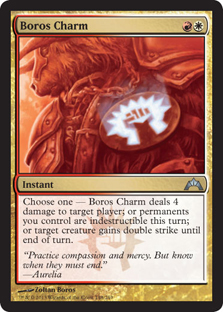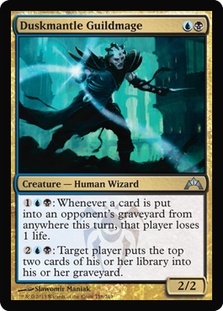Magic is a very cyclical thing.
Aside from infrequent introductions of new permanent types like planeswalker, each new set provides us with the opportunity to find out which historical archetypes might experience a resurgence in Constructed with the new cards we’re given.
Years ago, there was a lot of evolution. New ideas like Sligh showed that red offered something more than just a way to Shatter a Winter Orb. Now, though, we can learn a lot by looking at what has been done and deciding which new cards accomplish that task effectively.
One of the most powerful cards that’s been spoiled so far is Boros Charm.
Its most immediate and powerful use is tied to its versatility rather than just a damage number larger than three and a converted mana cost lower than four, a fact about which other talented writers have waxed eloquent. Boros Charm, in other words, is not just a big, dumb burn spell. Various R/x Aggro decks have put up strong finishes in recent weeks, and it seems natural that the versatility inherent in the newest Charm will bolster those strategies.
But let’s reexamine Boros Charm from the most obvious angle. It may be too on the nose to remind ourselves that it does four damage, but ember mages are not known for their diplomatic skills, after all.
Let’s look at how a burn deck operates at the most basic level. Even in a format like Legacy where the card quality is nearly as high as it can be, the basic principle is to maximize the amount of damage that each card does while minimizing its converted mana cost. To this end, Lightning Bolt is joined by Rift Bolt, Lava Spike, Chain Lightning, Fireblast, and other cheap burn spells in an effort to end the game with seven spells or fewer. In essence, burn decks are fairly simple combo decks with minimal interactivity. They basically ask the question "can you win the game before I draw and play the number of nonland cards equal to (your life)/(3)?"
Is it possible that, for the first time in recent memory, Standard will have an R/x deck that can function as a full-on burn deck? Although we don’t have Lightning Bolt, we have a fairly high volume of efficient burn spells, with Boros Charm leading the pack. Almost more important than Boros Charm, however, is Skullcrack, which provides a perfect counterpoint to the format’s Thragtusks and Sphinx’s Revelations.
Let’s look at the array of options set before us. In terms of pure, cheap direct damage, we have:
Brimstone Volley
Flames of the Firebrand
Pillar of Flame
Searing Spear
Thunderbolt
Skullcrack
Bump in the Night (requires black splash)
Boros Charm (requires white splash)
Thunderous Wrath (requires luck)
We also have a fairly wide variety of X-spells from which we might want to choose:
Bonfire of the Damned
Devil’s Play
Rakdos’s Return
Aurelia’s Fury
We certainly have the ability to fix our mana, even if we want to splash both white and black to play the maximum density of high-efficiency burn (note that the two "best" burn spells both require a splash color). Our greatest risks with this deck are that we will be killed by an aggressive strategy before we can complete our "combo" (i.e., burning out our opponent) or that we will flood out with lands and allow a midrange strategy to stabilize with Thragtusk.
This suggests that Bonfire of the Damned is our best choice among the X-spells. Even though Aurelia’s Fury is more versatile (and is probably the better card in quite a few decks), in this deck we don’t want to "waste time" dealing with creatures when we can continue to play burn spells. Because Bonfire of the Damned lends equal weight to both damage to creatures and damage to players and because we have no real need of a Falter effect during our own turn, it is probably the best card for a strategy like this one.
Further, we would like the ability to cheaply filter out cards that we don’t want (i.e., extra lands) for additional burn spells or for specific toolbox cards (Skullcrack). In this role, we might consider Faithless Looting.
Our draft deck for a pure burn strategy therefore might look like this:
Lands (23)
Spells (37)
- 4 Thunderbolt
- 1 Brimstone Volley
- 4 Bump in the Night
- 4 Faithless Looting
- 4 Bonfire of the Damned
- 4 Pillar of Flame
- 4 Flames of the Firebrand
- 4 Searing Spear
- 4 Skullcrack
- 4 Boros Charm
Sideboard

In the final build, Flames of the Firebrand gets the nod over Brimstone Volley because it will probably more frequently be the case that we can kill a creature and hit our opponent for one or two damage with Flames than it will be the case that we will kill a creature and have three additional mana for Brimstone Volley in the same turn.
Although there is not a lot of variability possible within the maindeck itself because of the limited number of cheap burn spells currently available in Standard, the sideboard is still very much a work in progress. There will be times when Rakdos Charm is simply a burn spell for five or six—it can effectively win the game for two mana in situations where many other cards could not against a good aggressive draw. Similarly, against a Snapcaster-style control deck, given that players will probably side out their removal, Ash Zealot is actually a decent card to bring in because its weakness as the only creature in the deck may be mitigated post-board. Rolling Temblor is a nod to the hyper-aggressive and hexproof decks.
Now, though, let’s take a walk to the other side of the Magic universe for a minute. We’ve explored a bit of Standard post-Gatecrash, so now let’s move in the opposite direction. Let’s take a look at a blue-based combo deck in Modern.
When Mindcrank was first spoiled, I really wanted it to be an effective combo piece in conjunction with Bloodchief Ascension. Unfortunately, it required far too much work to trigger the combo given that the optimal shell for doing so was an aggressive R/B list that didn’t really need to include a potential do-nothing like Mindcrank to be viable. Its time in Standard has passed, and it never amounted to anything aside from a fun diversion at FNM.
Now that Wizards of the Coast is pushing Modern as the Eternal PTQ format of choice, we have a lot more incentive to play it, even though there are still an awful lot of Bloodbraid Elves.
We also have a potentially interesting new card called Duskmantle Guildmage.
At first, I thought that he would be an effective combo in Standard along with a card like Jace, Memory Adept. However, if we already have Jace in play and are able to sustain him alongside a relatively fragile creature, aren’t we already winning? Do we really need to run the Guildmage just to speed up our clock one or two turns in a control deck?
Yes, we’re probably already winning, and no, we don’t really need the Guildmage in that scenario.
But there could be hope in Modern… Let’s take another look at our old friend Mindcrank.
If we have a Mindcrank in play and activate Duskmantle Guildmage, then the next time our opponent loses life or puts a card into their graveyard that turn they will lose the game. On the surface, this is a fairly simple two-card combo. However, the need to actually trigger the winning loop makes it slightly more difficult to use than we might assume. There are a lot of risks involved when attempting a combo with a 2/2 creature.
It would be one thing if we could simply play out the Guildmage on turn 5 and activate the ability to win the game. In order for that to work, we need another way to trigger the loop as well. Fortunately, if we simply play the creature and pass the turn, our opponent cannot play any spells to destroy either the Mindcrank or the Duskmantle Guildmage without risking having the loop triggered in response, so our opponent will need one additional removal spell for every three mana we have open.
The fact that both components of the combo cost two is also advantageous because we can use the old Heartbeat of Spring Combo’s best friend—transmute—to find the missing piece once we have one in hand.
Now that we have the basic pieces of the combo, we should look at other utility related to the combo.
Muddle the Mixture functions as a limited-use counterspell and as a way to Tutor for both pieces of the combo. Conveniently, it can also Tutor for Spellskite, which can be activated to protect both parts of the combo as well. Thoughtseize has seen play in a variety of combo decks in the past, and the fact that a successful Thoughtseize can also activate the infinite loop means that it has the potential to be an all-star in this initial list. While much of the remainder of the list will be a "stock" Modern combo list, it’s worth noting that we’ve included a single Sign in Blood as a transmute target that can also win the game once we’ve assembled our combo. In a pinch, it can be used for its traditional purpose, too.
This list is still in its infancy, and it is not clear yet whether it has any advantages over the combo decks that already exist in Modern (one strength, off the top of my head, is that an opposing Spellskite doesn’t interrupt the combo).
Creatures (7)
Lands (24)
Spells (27)
- 3 Sleight of Hand
- 4 Serum Visions
- 4 Muddle the Mixture
- 4 Remand
- 1 Slaughter Pact
- 4 Thoughtseize
- 1 Sign in Blood
- 2 Go for the Throat
- 4 Mindcrank
Sideboard

This list probably puts too much weight on the back of transmute, but it’s tough to tell without a lot of playtesting when tweaking a combo deck like this one.
Although the power level Gatecrash’s cards appeared to be lower than Return to Ravnica’s (when cards like Abrupt Decay were making massive waves) at first, it seems like there are some potential foundational cards in the first third of the set, leaving me excited to see what the rest has to offer.


